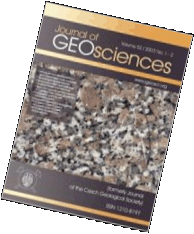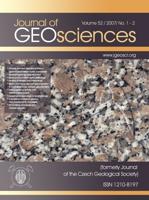 Export to Mendeley
Export to MendeleyMoldanubian Zone
Czech Republic
P-T conditions
Polička Unit
Svratka Unit
calc-silicate rocks
Original Paper
Garnet-forming reactions in calc-silicate rocks from the Polička Unit, Svratka Unit and SE part of the Moldanubian Zone
Journal of Geosciences, volume 54 (2009), issue 3, 245 - 268
DOI: http://doi.org/10.3190/jgeosci.051
Three main Variscan tectono-metamorphic units with distinct metamorphic evolution are present at the eastern boundary of the Bohemian Massif: Moldanubian Zone (MZ), Svratka Unit (SU) and Polička Unit (PU). All these metamorphic complexes contain calc-silicate rocks, which occur as bodies, layers or nodules within gneisses, mica schists, marbles, amphibolites or skarns. Calc-silicate rocks consist of quartz, plagioclase, diopside, titanite and sometimes amphibole, scapolite, garnet, minerals of the epidote group, K-feldspar and calcite.
Two groups of calc-silicate rocks are distinguished according to the presence/absence of garnet. The appearance of garnet is the result of continuous reactions among Fe-Ca-Al minerals. The dominant garnet-producing reaction calcite + quartz + clinozoisite = garnet + H2O + 5CO2 depends on the P-T conditions, XCO2 in the coexisting metamorphic fluids and bulk rock chemistry.
Phase relations and mineral compositions document a polymetamorphic history of the calc-silicate rocks. Calc-silicate rocks from the middle subunit of the PU have been affected by LP-MT metamorphism M1 and strongly overprinted by a temperature peak of the Variscan regional metamorphism under amphibolite-facies conditions (M2; 560-650 °C and 5-7 kbar). Calc-silicate rocks of the MZ, SU, and lower subunit of the PU reflect post-peak metamorphic decompression (M2) after MP-HT metamorphism (M1). Metamorphic P-T conditions of 640-680 °C and 6-7 kbar obtained for the calc-silicate rocks from the MZ and SU correspond to data from adjacent metapelites (M2) and are similar to the P-T conditions for metapelites from the lower subunit of the PU. The Variscan regional metamorphism in all the studied units was followed by younger, greenschist-facies metamorphism (M3).
The temperature, pressure and composition of metamorphic fluids were estimated from the mineral assemblages of the calc-silicate rocks and surrounding metapelites. The observed mineral reaction sequences require very low XCO2 values for calc-silicate nodules from the middle subunit of the PU and variable XCO2 values for the rest of the studied calc-silicate rocks. These variations in fluid composition were controlled by the size of the bodies, their bulk rock chemistry and/or the presence of carbonates in the surrounding rock complexes. The metamorphic assemblages with coexisting garnet and epidote group minerals from calc-silicate rocks are widespread in all the tectono-metamorphic units at the eastern margin of the Bohemian Massif. Appearance of comparable mineral assemblages in the rocks with variable geological evolution can be explained by the higher activity of hydrous fluids during metamorphic reactions in the surrounding metapelites at 550-680 °C and 5-7 kbar. The bulk rock chemistry and mineralogy of the calc-silicate rocks indicate that they were derived from silica-rich calcareous protoliths, such as marls or altered tuffs.
Webdesign inspired by aTeo. Hosted at the server of the Institute of Petrology and Structural Geology, Charles University, Prague.
ISSN: 1803-1943 (online), 1802-6222 (print)
email: jgeosci(at)jgeosci.org


IF (WoS, 2022): 1.4
5 YEAR IF (WoS, 2022): 1.8
Policy: Open Access
ISSN: 1802-6222
E-ISSN: 1803-1943